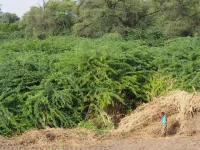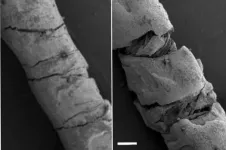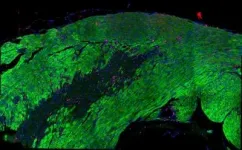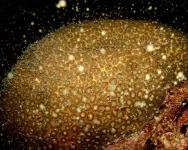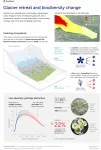Arctic warming and diminishing sea ice are influencing the atmosphere
Researchers of the University of Helsinki have resolved for the first time, how the environment affects the formation of nanoparticles in the Arctic. The results give additional insight into the future of melting sea ice and the Arctic atmosphere
2021-01-29
(Press-News.org) The researchers of the Institute for Atmospheric and Earth system research at the University of Helsinki have investigated how atmospheric particles are formed in the Arctic. Until recent studies, the molecular processes of particle formation in the high Arctic remained a mystery.
During their expeditions to the Arctic, the scientists collected measurements for 12 months in total. The results of the extensive research project were recently published in the Geophysical Research Letters journal.
The researchers discovered that atmospheric vapors, particles, and cloud formation have clear differences within various Arctic environments. The study clarifies how Arctic warming and sea ice loss strengthens processes where different vapors are emitted to the atmosphere. The thinning of sea ice enables more iodine emissions while broader open waters enable more emissions of sulfur-containing vapors.
Higher concentrations of vapors result in a higher amount of particles. This on the other hand will lead to more clouds, which can - depending on the season and location - either slow down or accelerate the Arctic warming. Detailed knowledge of these processes is crucial in order to understand the consequences of global warming.
"Our observations are contributing to further understanding of what happens in the Arctic atmosphere due to warming. In general, atmospheric particles and clouds play an important role in regulating the atmosphere's temperature, and any changing behavior of these has consequences on Arctic warming. Arctic areas are especially sensitive to changes in cloudiness and albedo", says Lisa Beck, a doctoral student at the Institute for Atmospheric and Earth System Research (INAR).
More information about the future of melting sea ice
The researchers conducted measurements in Northern Greenland at Villum research station and in Svalbard at Ny-Ålesund for 6-months at each station. While both sites are located at similar latitudes, about 1000 km south of the North Pole, their environments are very different. Villum-station is surrounded by sea ice all year round, while the warm sea currents cause the sea around Ny-Ålesund to remain open.
In Northern Greenland the researchers discovered that in the spring after the Polar night the microalgae below the sea ice started to emit iodine compounds to the atmosphere. As the spring continues, the thinning sea ice leads to the emission of even more iodine compounds. These compounds form molecular clusters that can grow into bigger particles.
In Svalbard, surrounded by open waters, the observations showed how sulfur-compounds emitted by phytoplankton could form a large amount of particles that could grow fast, and can even form cloud droplets. In the studies of Svalbard also organic compounds were detected.
The large amount and role of organic compounds in the Arctic particle formation surprised the researchers.
"We did not expect to observe many organic vapors in the cold and bare Arctic environment as they have been mainly seen in areas covered by forests. We are planning to continue the studies in Svalbard to figure out what these organic compounds are and where they are coming from", Beck says.
The particle concentrations in Svalbard were clearly higher than the ones measured in Northern-Greenland.
"Currently, the Arctic sea ice is melting fast. As a result, we can assume that the processes observed in Svalbard will be more common in the Arctic areas that will be liberated from sea ice", Beck says.
INFORMATION:
The published research is connected to the recent Polarstern studies that have continued the studies in the high Arctic in the middle of sea ice areas.
More information:
Lisa Beck
Doctoral student, University of Helsinki
Institute for Atmospheric and Earth System Research (INAR)
lisa.beck@helsinki.fi
Nina Sarnela
Postdoctoral researcher, University of Helsinki
Institute for Atmospheric and Earth System Research (INAR)
+358505741513,
nina.sarnela@helsinki.fi
@NinaSarnela
Mikko Sipilä
Associate professor, University of Helsinki
Institute for Atmospheric and Earth System Research (INAR)
+358407093103
mikko.sipila@helsinki.fi
Read more:
The Polar and arctic atmospheric research group
[Attachments] See images for this press release:
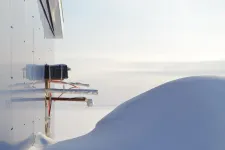
ELSE PRESS RELEASES FROM THIS DATE:
2021-01-29
The Covid-19 pandemic has made home offices, virtual meetings and remote learning the norm, and it is likely here to stay. But are people paying attention in online meetings? Are students paying attention in virtual classrooms? Researchers Jens Madsen and Lucas C. Parra from City College of New York, demonstrate how eye tracking can be used to measure the level of attention online using standard web cameras, without the need to transfer any data from peoples computers, thus preserving privacy. In a paper entitled "Synchronized eye movements predict test scores in online video education," published in the Proceedings of the National Academy of Sciences, they show that just ...
2021-01-29
Scientists at Johannes Gutenberg University Mainz (JGU) and ETH Zurich have developed a process to produce commodity chemicals in a much less hazardous way than was previously possible. Such commodity chemicals represent the starting point for many mass-produced products in the chemical industry, such as plastics, dyes, and fertilizers, and are usually synthesized with the help of chlorine gas or bromine, both of which are extremely toxic and highly corrosive. In the current issue of Science, the researchers report that they have been able to utilize electrolysis, i.e., the application of an electric current, to obtain chemicals known as dichloro and dibromo compounds, which can then be used to synthesize ...
2021-01-29
A new study has found that mobile apps can play a vital role in helping immigrants integrate into new cultures, as well as provide physical and mental health benefits.
Researchers at Anglia Ruskin University (ARU) surveyed new migrants and refugees undertaking free beginners' language classes in Greece, often the first destination for people arriving into Europe from Africa and Asia, over a 10-month period.
The findings, published in the journal Computers in Human Behavior, show that those using mobile apps aided by artificial intelligence (AI), such as language assistants, customised information sites, or health symptom trackers, experienced ...
2021-01-29
New research has revealed how an invasion of the alien evergreen tree, Prosopis juliflora seriously diminishes water resources in the Afar Region of Ethiopia, consuming enough of this already scarce resource to irrigate cotton and sugarcane generating some US$ 320 million and US$ 470 million net benefits per year.
A team of Ethiopian, South African and Swiss scientists, including lead author Dr Hailu Shiferaw, Dr Tena Alamirew, and Dr Gete Zeleke from the Water and Land Resource Centre of Addis Ababa University, Ethiopia, and Dr Sebinasi Dzikiti from Stellenbosch University, ...
2021-01-29
Scientists have broadened our understanding of how 'weak' cells bond with their more mature cellular counterparts to boost the body's production of insulin, improving our knowledge of the processes leading to type 2 diabetes - a significant global health problem.
Type 2 diabetes mellitus occurs when β-cells cannot release enough insulin - a tightly controlled process requiring hundreds of such cells clustered together to co-ordinate their response to signals from food, such as sugar, fat and gut hormones.
An international research team - led by scientists at the University of ...
2021-01-29
Engineers at Tufts University have created and demonstrated flexible thread-based sensors that can measure movement of the neck, providing data on the direction, angle of rotation and degree of displacement of the head. The discovery raises the potential for thin, inconspicuous tatoo-like patches that could, according to the Tufts team, measure athletic performance, monitor worker or driver fatigue, assist with physical therapy, enhance virtual reality games and systems, and improve computer generated imagery in cinematography. The technology, described today in Scientific Reports, adds to a growing number of thread-based ...
2021-01-29
Researchers from the Hubrecht Institute mapped the recovery of the heart after a heart attack with great detail. They found that heart muscle cells - also called cardiomyocytes - play an important role in the intracellular communication after a heart attack. The researchers documented their findings in a database that is accessible for scientists around the world. This brings the research field a step closer to the development of therapies for improved recovery after heart injury. The results were published in Communications Biology on the 29th of January.
In the Netherlands, an average of 95 people end up in the hospital each day ...
2021-01-29
Efforts to understand when corals reproduce have been given a boost thanks to a new resource that gives scientists open access to more than forty years' worth of information about coral spawning.
Led by researchers at Newcastle University, UK, and James Cook University, Australia, the Coral Spawning Database (CSD) for the first time collates vital information about the timing and geographical variation of coral spawning. This was a huge international effort that includes over 90 authors from 60 institutions in 20 countries.
The data can be used by scientists and conservationists to better understand the environmental cues that influence when coral ...
2021-01-29
(Singapore--16:45 p.m. SPT/3:45 EST January 29, 2021)--Two presentations from the ADAURA clinical trial advanced previous research that demonstrated improved disease-fee survival (DFS) outcomes for patients with surgically resected non-small cell lung cancer (NSCLC) receiving osimertinib. The data were reported today at the International Association for the Study of Lung Cancer's 2020 World Conference on Lung Cancer (WCLC) Singapore.
Osimertinib is a third-generation, irreversible, central nervous system-active, epidermal growth factor receptor (EGFR)-tyrosine kinase inhibitor. ADAURA is a randomized Phase III trial comparing adjuvant osimertinib with placebo in patients ...
2021-01-29
Beyond the ski slopes, one of the most iconic symbols of the Alps are the alpine flowers. These plants are not only beautiful -- they are also used in liqueurs and medicines, and they form the foundation of the local food chains. But a recent study in Frontiers in Ecology and Evolution shows that, although plant diversity may initially increase with glacier retreat, many of these species may soon become endangered.
"Our results indicate that plant diversity will ultimately decrease once the glaciers disappear -- and up to 22% of the species we analyzed may locally disappear or even go extinct once the glaciers are gone," says lead author Dr Gianalberto Losapio of Stanford University in the USA. "We show that 'not all species are equal before global warming' and that there are some species ...
LAST 30 PRESS RELEASES:
[Press-News.org] Arctic warming and diminishing sea ice are influencing the atmosphere
Researchers of the University of Helsinki have resolved for the first time, how the environment affects the formation of nanoparticles in the Arctic. The results give additional insight into the future of melting sea ice and the Arctic atmosphere


